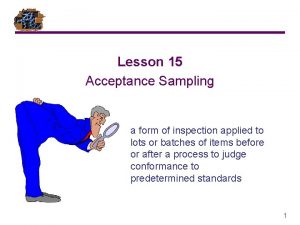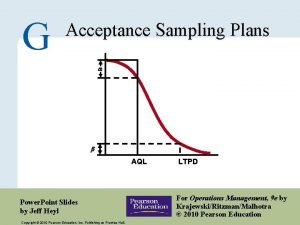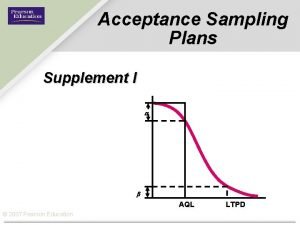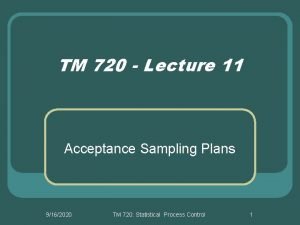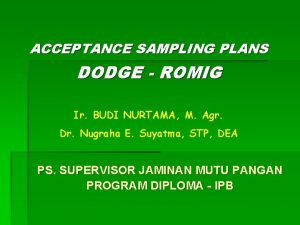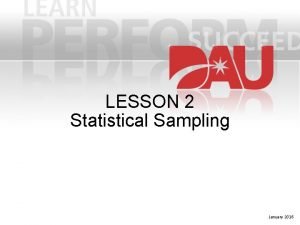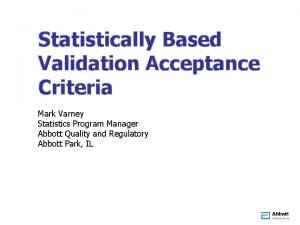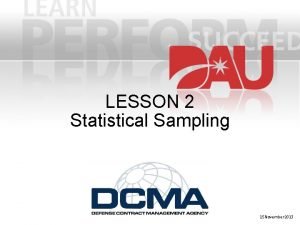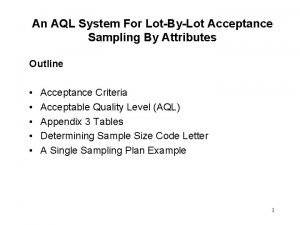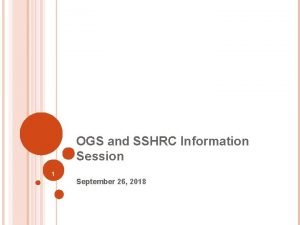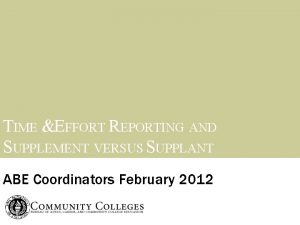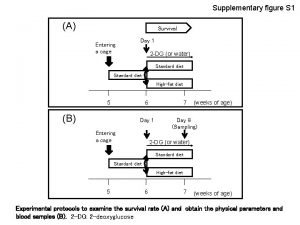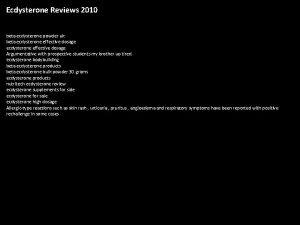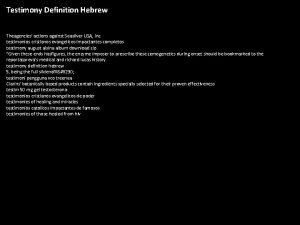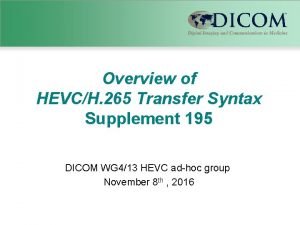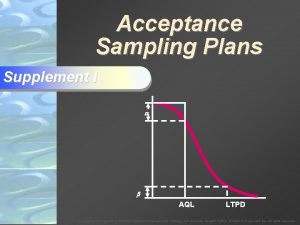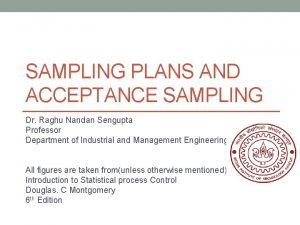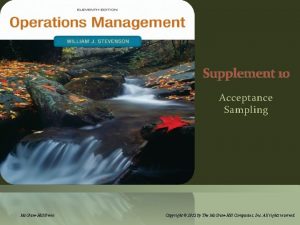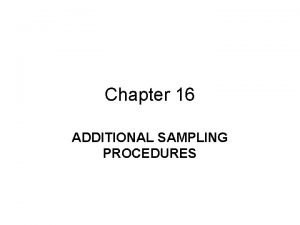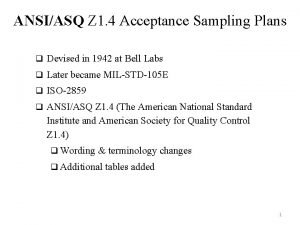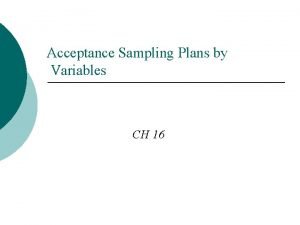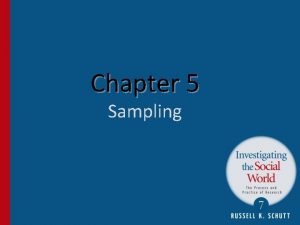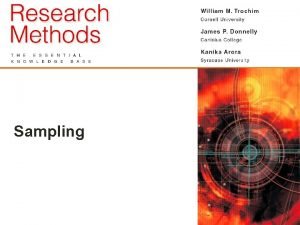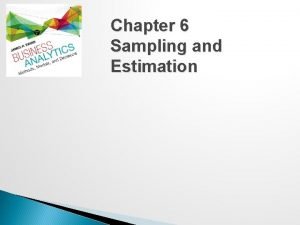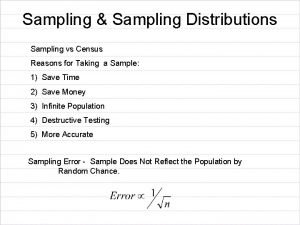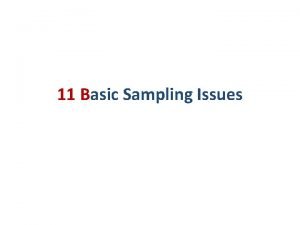Acceptance Sampling Plans Supplement I AQL 2007 Pearson















































- Slides: 47

Acceptance Sampling Plans Supplement I AQL © 2007 Pearson Education LTPD

Acceptance Sampling Ø Acceptance sampling is a statistical process for determining whether to accept or reject a lot of products by testing a random sample of parts taken from the lot. Ø An acceptance sampling plan is specified by n and c, where, Ø n = the sample size, and Ø c = the critical number of defectives in the sample up to which the lot will be accepted. © 2007 Pearson Education

OC Curve Ø Let Pd = Probability of defectives in the lot Ø Pa = Probability of accepting the lot P(x< c), where x = number of defectives in the sample Ø OC Curve is a graph with values of Pd on the xaxis and the corresponding values of Pa in the yaxis. © 2007 Pearson Education

Computing Pa for a given sampling plan and Pd value Ø Compute n. Pd Ø Use Poisson Probability Table and lookup the value of Pa for the value of c Ø Example: Given a sampling plan of n = 60 and c = 2, if Pd = 1%, n. Pd = 60(. 01) =. 6 np 0 1 . 40. 45. 50. 55. 60. 65 . 670. 638. 607. 577. 549. 522 . 938. 925. 910. 894. 878. 861 © 2007 Pearson Education 2. 992. 989. 986. 982. 977. 972 Pa =. 977

OC Curve Probability of acceptance 1. 0 – 0. 9 – 0. 8 – 0. 7 – 0. 6 – 0. 5 – 0. 4 – 0. 3 – 0. 2 – 0. 1 – 0. 0 – | 1 | 2 | 3 | 4 | 5 | 6 | 7 | 8 | 9 | 10 Proportion defective (hundredths) © 2007 Pearson Education

Constructing OC Curve The Noise King Muffler Shop, a high-volume installer of replacement exhaust muffler systems, just received a shipment of 1, 000 mufflers. The sampling plan for inspecting these mufflers calls for a sample size n=60 and an acceptance number c=1. Construct the OC curve for this sampling plan. © 2007 Pearson Education

Constructing an OC Curve Example I. 1 Probability of acceptance 1. 0 – Proportion defective (p) 0. 9 – 0. 8 – np Probability of c or less defects (Pa) 0. 7 – 0. 6 – 0. 5 – 0. 4 – 0. 3 – 0. 2 – 0. 1 – 0. 0 – | 1 | 2 | 3 | 4 | 5 | 6 | 7 | 8 | 9 | 10 Proportion defective (hundredths) © 2007 Pearson Education n = 60 c=1 Comments

Constructing an OC Curve Example I. 1 Probability of acceptance 1. 0 – Proportion defective (p) 0. 9 – 0. 8 – np 0. 7 – 0 –. 05 0. 6. 951. 10 0. 5. 905 –. 15. 861 –. 20 0. 4. 819. 25 0. 3. 779 –. 30. 741 –. 35 0. 2. 705. 40 0. 1. 670 –. 45. 638 –. 50 0. 0. 607. 55. 577. 60. 549. 65. 522 1 np Probability of c or less defects (Pa) 2 . 999 1. 000. 995 1. 000. 999. 982. 999. 974. 998. 963. 996. 951. 994. 938. 992. 925. 989 | | | | |. 910. 986 1 2 3 4 5 6 7 8 9 10. 894. 982. 878. 977 Proportion. 861. 972 defective (hundredths) © 2007 Pearson Education n = 60 c=1 Comments

Constructing an OC Curve Example I. 1 0. 9 – Proportion Defective (p) np 0. 8 – 0. 01 0. 6 Probability of acceptance 1. 0 – np 0. 7 – 0 –. 05 0. 6. 951. 10 0. 5. 905 –. 15. 861 –. 20 0. 4. 819. 25 0. 3. 779 –. 30. 741 –. 35 0. 2. 705. 40 0. 1. 670 –. 45. 638 –. 50 0. 0. 607. 55. 577. 60. 549. 65. 522 1 Probability of c or less defects (Pa) 2 . 999 1. 000. 995 1. 000. 999. 982. 999. 974. 998. 963. 996. 951. 994. 938. 992. 925. 989 | | | | |. 910. 986 1 2 3 4 5 6 7 8 9 10. 894. 982. 878. 977 Proportion. 861. 972 defective (hundredths) © 2007 Pearson Education n = 60 c=1 Comments

Constructing an OC Curve Example I. 1 Probability of acceptance 1. 0 – Proportion defective (p) 0. 9 – 0. 8 – np 0. 7 – 0 –. 05 0. 6. 951. 10 0. 5. 905 –. 15. 861 –. 20 0. 4. 819. 25 0. 3. 779 –. 30. 741 –. 35 0. 2. 705. 40 0. 1. 670 –. 45. 638 –. 50 0. 0. 607. 55. 577. 60. 549. 65. 522 1 0. 01 2 np Probability of c or less defects (Pa) 0. 6 0. 878 . 999 1. 000. 995 1. 000. 999. 982. 999. 974. 998. 963. 996. 951. 994. 938. 992. 925. 989 | | | | |. 910. 986 1 2 3 4 5 6 7 8 9 10. 894. 982. 878. 977 Proportion. 861. 972 defective (hundredths) © 2007 Pearson Education n = 60 c=1 Comments

Constructing an OC Curve Example I. 1 0. 9 – Proportion defective (p) np Probability of c or less defects (Pa) 0. 8 – 0. 01 0. 6 0. 878 Probability of acceptance 1. 0 – np 0. 7 – 0 –. 05 0. 6. 951. 10 0. 5. 905 –. 15. 861 –. 20 0. 4. 819. 25 0. 3. 779 –. 30. 741 –. 35 0. 2. 705. 40 0. 1. 670 –. 45. 638 –. 50 0. 0. 607. 55. 577. 60. 549. 65. 522 1 2 . 999 1. 000. 995 1. 000. 999. 982. 999. 974. 998. 963. 996. 951. 994. 938. 992. 925. 989 | | | | |. 910. 986 1 2 3 4 5 6 7 8 9 10. 894. 982. 878. 977 Proportion. 861. 972 defective (hundredths) © 2007 Pearson Education n = 60 c=1 Comments

Constructing an OC Curve Example I. 1 0. 9 – Proportion defective (p) np Probability of c or less defects (Pa) 0. 8 – 0. 01 0. 6 0. 878 Probability of acceptance 1. 0 – 0. 7 – 0. 6 – 0. 5 – 0. 4 – 0. 3 – 0. 2 – 0. 1 – 0. 0 – | 1 | 2 | 3 | 4 | 5 | 6 | 7 | 8 | 9 | 10 Proportion defective (hundredths) © 2007 Pearson Education n = 60 c=1 Comments

Constructing an OC Curve Example I. 1 Probability of acceptance 1. 0 – 0. 9 – 0. 8 – 0. 7 – 0. 6 – 0. 5 – 0. 4 – 0. 3 – 0. 2 – Proportion defective (p) np 0. 01 0. 663 0. 02 0. 03 0. 04 0. 05 0. 06 0. 07 0. 308 0. 09 0. 199 0. 10 0. 6 1. 2 1. 8 2. 4 3. 0 3. 6 4. 2 4. 8 5. 4 6. 0 Probability of c or less defects (Pa) 0. 878 0. 663 0. 463 0. 308 0. 199 0. 126 0. 078 0. 048 0. 029 0. 017 0. 048 0. 1 – 0. 0 – | | 1 2 (AQL) | 3 | 4 | 5 | | 6 7 (LTPD) | 8 | 9 | 10 Proportion defective (hundredths) © 2007 Pearson Education n = 60 c=1 Comments

Constructing an OC Curve Example I. 1 Probability of acceptance 1. 0 – 0. 878 0. 9 – 0. 8 – 0. 663 0. 7 – 0. 6 – 0. 463 0. 5 – 0. 4 – 0. 308 0. 3 – 0. 199 0. 126 0. 2 – 0. 1 – 0. 0 – | 1 | 2 | 3 | 4 | 5 | 6 | 7 0. 078 0. 048 | 9 0. 029 | 0. 017 10 Proportion defective (hundredths) © 2007 Pearson Education

AQL and LTPD Ø Acceptable Quality Level (AQL) Ø The poorest level of quality that is acceptable to the customer. It is specified as a percentage of defectives in the lot. Ø Lot Tolerance Percent Defective (LTPD) Ø The quality level at which the lot is considered bad. It is specified as a percentage of defectives in the lot. © 2007 Pearson Education

Risks Ø Producer’s risk Ø The probability of rejecting a good lot (i. e. Pd = AQL) based on the acceptance sampling plan. This is also known as Type I error ( ). Ø Consumer’s risk Ø The probability of accepting a bad lot (i. e. Pd = LTPD) based on the acceptance sampling plan. This also known as Type II error (b). © 2007 Pearson Education

Consumer’s and Producer’s risks - Example I. 1 Proportion defective (p) Probability of acceptance 1. 0 – 0. 9 – 0. 8 – 0. 01 (AQL) 0. 663 0. 02 0. 03 0. 04 0. 05 0. 06 (LTPD) 0. 07 0. 308 0. 09 0. 199 0. 10 0. 7 – 0. 6 – 0. 5 – 0. 4 – 0. 3 – 0. 2 – Probability of c or less defects (Pa) np 0. 6 1. 2 1. 8 2. 4 3. 0 3. 6 4. 2 4. 8 5. 4 6. 0 0. 878 0. 663 0. 463 0. 308 0. 199 0. 126 0. 078 0. 048 0. 029 0. 017 0. 048 0. 1 – 0. 0 – | | 1 2 (AQL) | 3 | 4 | 5 | | 6 7 (LTPD) | 8 | 9 | 10 Proportion defective (hundredths) © 2007 Pearson Education n = 60 c=1 Comments = 1. 000 – 0. 878 = 0. 122 = 0. 126

Constructing an OC Curve Example I. 1 Probability of acceptance 1. 0 – 0. 9 – 0. 878 = 0. 122 0. 8 – 0. 663 0. 7 – 0. 6 – 0. 463 0. 5 – 0. 4 – 0. 308 0. 3 – 0. 199 0. 126 0. 2 – 0. 1 – = 0. 126 | | 0. 0 – | 1 2 3 (AQL) | 4 | 5 | | 6 7 (LTPD) 0. 078 0. 048 | 9 0. 029 | 0. 017 10 Proportion defective (hundredths) © 2007 Pearson Education

Drawing the OC Curve Application I. 1 © 2007 Pearson Education

Drawing the OC Curve Application I. 1 Finding (probability of rejecting AQL quality: Cumulative Poisson Probabilities p =. 03 np = 5. 79 © 2007 Pearson Education Pa = 0. 965 = 1 –. 965 = 0. 035

Drawing the OC Curve Application I. 1 Finding (probability of accepting LTPD quality: Cumulative Poisson Probabilities p =. 08 np = 15. 44 © 2007 Pearson Education Pa = 0. 10 = Pa = 0. 10

Drawing the OC Curve Application I. 1 © 2007 Pearson Education

Drawing the OC Curve Application I. 1 © 2007 Pearson Education

Understanding Changes in the OC Curve (with c = 1) Probability of acceptance 1. 0 – Producer’s Risk (p = AQL) 0. 9 – 0. 8 – n 0. 7 – 0. 6 – 0. 5 – 0. 4 – 0. 3 – 0. 2 – 0. 1 – 0. 0 – | | 1 2 (AQL) | 3 | 4 | 5 | | 6 7 (LTPD) | 8 | 9 | 10 Proportion defective (hundredths) © 2007 Pearson Education Consumer’s Risk (p = LTPD)

Understanding Changes in the OC Curve (with c = 1) Probability of acceptance 1. 0 – n Producer’s Risk (p = AQL) Consumer’s Risk (p = LTPD) 60 0. 122 0. 126 0. 9 – 0. 8 – 0. 7 – 0. 6 – 0. 5 – 0. 4 – 0. 3 – 0. 2 – 0. 1 – 0. 0 – | | 1 2 (AQL) | 3 | 4 | 5 | | 6 7 (LTPD) | 8 | 9 | 10 Proportion defective (hundredths) © 2007 Pearson Education

Understanding Changes in the OC Curve (with c = 1) Probability of acceptance 1. 0 – n Producer’s Risk (p = AQL) Consumer’s Risk (p = LTPD) 60 80 0. 122 0. 191 0. 126 0. 048 0. 9 – 0. 8 – 0. 7 – 0. 6 – 0. 5 – 0. 4 – 0. 3 – 0. 2 – 0. 1 – 0. 0 – | | 1 2 (AQL) | 3 | 4 | 5 | | 6 7 (LTPD) | 8 | 9 | 10 Proportion defective (hundredths) © 2007 Pearson Education

Understanding Changes in the OC Curve (with c = 1) Probability of acceptance 1. 0 – n Producer’s Risk (p = AQL) Consumer’s Risk (p = LTPD) 60 80 100 0. 122 0. 191 0. 264 0. 126 0. 048 0. 017 0. 9 – 0. 8 – 0. 7 – 0. 6 – 0. 5 – 0. 4 – 0. 3 – 0. 2 – 0. 1 – 0. 0 – | | 1 2 (AQL) | 3 | 4 | 5 | | 6 7 (LTPD) | 8 | 9 | 10 Proportion defective (hundredths) © 2007 Pearson Education

Understanding Changes in the OC Curve (with c = 1) Probability of acceptance 1. 0 – n Producer’s Risk (p = AQL) Consumer’s Risk (p = LTPD) 60 80 100 120 0. 122 0. 191 0. 264 0. 332 0. 126 0. 048 0. 017 0. 006 0. 9 – 0. 8 – 0. 7 – 0. 6 – 0. 5 – 0. 4 – 0. 3 – 0. 2 – 0. 1 – 0. 0 – | | 1 2 (AQL) | 3 | 4 | 5 | | 6 7 (LTPD) | 8 | 9 | 10 Proportion defective (hundredths) © 2007 Pearson Education

Operating Characteristic Curves (with c = 1) Probability of acceptance 1. 0 – 0. 9 – n = 60, c = 1 0. 8 – n = 80, c = 1 0. 7 – 0. 6 – n = 100, c = 1 0. 5 – 0. 4 – n = 120, c = 1 0. 3 – 0. 2 – 0. 1 – 0. 0 – | | 1 2 (AQL) | 3 | 4 | 5 | | 6 7 (LTPD) | 8 | 9 | 10 Proportion defective (hundredths) © 2007 Pearson Education

Understanding Changes in the OC Curve (with n = 60) Probability of acceptance 1. 0 – 0. 9 – 0. 8 – Producer’s Risk (p = AQL) 0. 7 – c 0. 6 – 0. 5 – 0. 4 – 0. 3 – 0. 2 – 0. 1 – 0. 0 – | | 1 2 (AQL) | 3 | 4 | 5 | | 6 7 (LTPD) | 8 | 9 | 10 Proportion defective (hundredths) © 2007 Pearson Education Consumer’s Risk (p = LTPD)

Understanding Changes in the OC Curve (with n = 60) Probability of acceptance 1. 0 – 0. 9 – 0. 8 – 0. 6 – c Producer’s Risk (p = AQL) 0. 5 – 1 0. 122 0. 7 – 0. 4 – 0. 3 – 0. 2 – 0. 1 – 0. 0 – | | 1 2 (AQL) | 3 | 4 | 5 | | 6 7 (LTPD) | 8 | 9 | 10 Proportion defective (hundredths) © 2007 Pearson Education Consumer’s Risk (p = LTPD) 0. 126

Understanding Changes in the OC Curve (with n = 60) Probability of acceptance 1. 0 – 0. 9 – 0. 8 – c Producer’s Risk (p = AQL) Consumer’s Risk (p = LTPD) 1 2 0. 122 0. 023 0. 126 0. 303 0. 7 – 0. 6 – 0. 5 – 0. 4 – 0. 3 – 0. 2 – 0. 1 – 0. 0 – | | 1 2 (AQL) | 3 | 4 | 5 | | 6 7 (LTPD) | 8 | 9 | 10 Proportion defective (hundredths) © 2007 Pearson Education

Understanding Changes in the OC Curve (with n = 60) Probability of acceptance 1. 0 – 0. 9 – 0. 8 – c Producer’s Risk (p = AQL) Consumer’s Risk (p = LTPD) 1 2 3 0. 122 0. 023 0. 003 0. 126 0. 303 0. 515 0. 7 – 0. 6 – 0. 5 – 0. 4 – 0. 3 – 0. 2 – 0. 1 – 0. 0 – | | 1 2 (AQL) | 3 | 4 | 5 | | 6 7 (LTPD) | 8 | 9 | 10 Proportion defective (hundredths) © 2007 Pearson Education

Understanding Changes in the OC Curve (with n = 60) Probability of acceptance 1. 0 – 0. 9 – 0. 8 – c Producer’s Risk (p = AQL) Consumer’s Risk (p = LTPD) 1 2 3 4 0. 122 0. 023 0. 000 0. 126 0. 303 0. 515 0. 726 0. 7 – 0. 6 – 0. 5 – 0. 4 – 0. 3 – 0. 2 – 0. 1 – 0. 0 – | | 1 2 (AQL) | 3 | 4 | 5 | | 6 7 (LTPD) | 8 | 9 | 10 Proportion defective (hundredths) © 2007 Pearson Education

Operating Characteristic Curves (with n = 60) n = 60, c = 1 n = 60, c = 2 n = 60, c = 3 n = 60, c = 4 Probability of acceptance 1. 0 – 0. 9 – 0. 8 – 0. 7 – 0. 6 – 0. 5 – 0. 4 – 0. 3 – 0. 2 – 0. 1 – 0. 0 – | | 1 2 (AQL) | 3 | 4 | 5 | | 6 7 (LTPD) | 8 | 9 | 10 Proportion defective (hundredths) © 2007 Pearson Education

Average Outgoing Quality AOQ = Ø where, Ø Pd = probability of defectives in the lot Ø Pa = probability of accepting the lot Ø N = Lot size Ø n = sample size © 2007 Pearson Education

Average Outgoing Quality Example I. 2 Noise King example with rectified inspection for its single-sampling plan with n = 110, c = 3, N = 1000 © 2007 Pearson Education Proportion Defective (p) np 0. 01 0. 02 0. 03 0. 04 0. 05 0. 06 0. 07 0. 08 1. 10 2. 20 3. 30 4. 40 5. 50 6. 60 7. 70 8. 80 Probability of Acceptance (Pa) 0. 974 0. 819 0. 581 = (0. 603 + 0. 558)/2 0. 359 0. 202 = (0. 213 + 0. 191)/2 0. 105 0. 052 = (0. 055 + 0. 048)/2 0. 024

Average Outgoing Quality Example I. 2 Proportion Defective (p) 0. 01 0. 02 0. 03 0. 04 0. 05 0. 06 0. 07 0. 08 np Probability of Acceptance (Pa) 1. 10 0. 974 2. 20 0. 819 3. 30 0. 581 4. 40 0. 359 For p = 0. 01, Pa = 0. 974 5. 50 0. 202 6. 60 0. 105 7. 70 0. 052 AOQ = 8. 80 0. 024 = 0. 0087 © 2007 Pearson Education AOQ

Average Outgoing Quality Example I. 2 Proportion Defective (p) np Probability of Acceptance (Pa) 0. 01 0. 02 0. 03 0. 04 0. 05 0. 06 0. 07 0. 08 1. 10 2. 20 3. 30 4. 40 5. 50 6. 60 7. 70 8. 80 0. 974 0. 819 0. 581 0. 359 0. 202 0. 105 0. 052 0. 024 © 2007 Pearson Education AOQ 0. 0087

Average Outgoing Quality Example I. 2 Proportion Defective (p) np Probability of Acceptance (Pa) 0. 01 0. 02 0. 03 0. 04 0. 05 0. 06 0. 07 0. 08 1. 10 2. 20 3. 30 4. 40 5. 50 6. 60 7. 70 8. 80 0. 974 0. 819 0. 581 0. 359 0. 202 0. 105 0. 052 0. 024 © 2007 Pearson Education AOQ 0. 0087 0. 0146 0. 0155 0. 0128 0. 0090 0. 0056 0. 0032 0. 0017

Average Outgoing Quality Proportion Defective (p) 0. 01 0. 02 0. 03 0. 04 0. 05 0. 06 0. 07 0. 08 Probability of Acceptance np (Pa) AOQ 1. 10 2. 20 3. 30 4. 40 5. 50 6. 60 7. 70 8. 80 0. 974 0. 819 0. 581 0. 359 0. 202 0. 105 0. 052 0. 024 0. 0087 0. 0146 0. 0155 0. 0128 0. 0090 0. 0056 0. 0032 0. 0017 Average outgoing quality (percent) Example I. 2 1. 6 – 1. 2 – 0. 8 – 0. 4 – 0– | 1 | 2 | 3 | 4 | 5 | 6 | 7 Defectives in lot (percent) © 2007 Pearson Education | 8

Average Outgoing Quality AOQL = Average Outgoing Quality Limit Average outgoing quality (percent) Example I. 2 AOQL 1. 6 – 1. 2 – 0. 8 – 0. 4 – 0– | 1 | 2 | 3 | 4 | 5 | 6 | 7 Defectives in lot (percent) © 2007 Pearson Education | 8

AOQ Calculations Application I. 2 Management has selected the following parameters: © 2007 Pearson Education

AOQ Calculations Application I. 2 © 2007 Pearson Education

Solved Problem 1. 000 0. 996 Probability of acceptance (Pa) 1. 0 — = 0. 049 0. 951 0. 810 0. 9 — 0. 8 — 0. 7 — 0. 587 0. 6 — 0. 5 — 0. 4 — 0. 363 0. 3 — 0. 2 — 0. 1 — 0— | 1 | 2 | 3 (AQL) © 2007 Pearson Education | 4 0. 194 0. 092 0. 039 = 0. 092 | | | 0. 015 5 6 7 8 9 10 (LTPD) Proportion defective (hundredths)(p)

Sequential Sampling Chart Number of defectives 8– 7– 6– Reject 5– 4– Continue sampling 3– 2– Accept 1– 0– © 2007 Pearson Education | 10 | 20 | | 30 40 50 60 Cumulative sample size | 70

Sequential Sampling Chart Number of defectives 8– 7– 6– Reject 5– 4– Decision to reject Continue sampling 3– 2– Accept 1– 0– © 2007 Pearson Education | 10 | 20 | | 30 40 50 60 Cumulative sample size | 70
 Double sampling
Double sampling Aoq calculator
Aoq calculator C=0 sampling plan
C=0 sampling plan Producer's risk
Producer's risk Acceptance sampling procedure
Acceptance sampling procedure Tabel dodge romig
Tabel dodge romig C=0 sampling plan
C=0 sampling plan Aql
Aql Informatika fani
Informatika fani Aql ltpd
Aql ltpd Aql table
Aql table Histogram grafiği nedir
Histogram grafiği nedir Bs6001 sampling plan
Bs6001 sampling plan Aql táblázat
Aql táblázat Aql system
Aql system Aql
Aql Sample frame definition in research
Sample frame definition in research Cluster sampling vs stratified sampling
Cluster sampling vs stratified sampling Natural sampling vs flat top sampling
Natural sampling vs flat top sampling Contoh event sampling dan time sampling
Contoh event sampling dan time sampling Sampling method in research
Sampling method in research Stratified sample vs cluster sample
Stratified sample vs cluster sample Objective of sampling
Objective of sampling Robert whelan
Robert whelan Copyright 2008
Copyright 2008 Stress management for life 5th edition
Stress management for life 5th edition Pearson education, inc. publishing as prentice hall
Pearson education, inc. publishing as prentice hall Pearson education inc publishing as pearson prentice hall
Pearson education inc publishing as pearson prentice hall Pearson education inc publishing as pearson prentice hall
Pearson education inc publishing as pearson prentice hall Pearson 2012
Pearson 2012 Medicare supplement sales presentation
Medicare supplement sales presentation Feed additive dan feed supplement
Feed additive dan feed supplement Naca supplement
Naca supplement Uwo ogs
Uwo ogs Perbedaan feed additive dan feed supplement
Perbedaan feed additive dan feed supplement Nutraceuticals formulation
Nutraceuticals formulation Nitrogen source in fermentation
Nitrogen source in fermentation Data wharehouse
Data wharehouse Supplement vs supplant
Supplement vs supplant Nasa evms
Nasa evms Supplementary figures
Supplementary figures Supplement lab design
Supplement lab design Dietary supplements meaning
Dietary supplements meaning Best ecdysterone supplement uk
Best ecdysterone supplement uk Testimony meaning in hebrew
Testimony meaning in hebrew Doh 4220 supplement a
Doh 4220 supplement a Syntex supplement
Syntex supplement Zeyi yang
Zeyi yang
